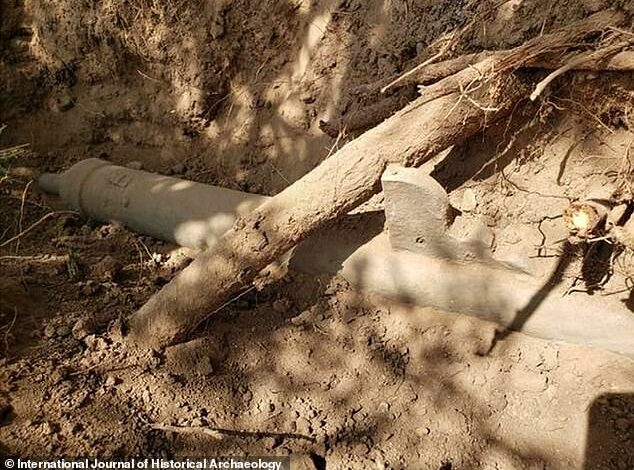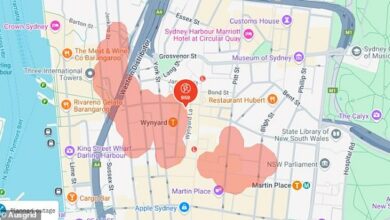‘First ever weapon’ used 500 years ago by explorers searching for the ‘Seven Cities of Gold’ has been discovered in Arizona

Archaeologists have discovered America’s first firearm, used nearly 500 years ago by explorers searching for the ‘Seven Cities of Gold’.
The bronze cannon, or wall cannon, was part of the Coronado expedition led by Spanish conquistador Francisco Vázquez de Coronado, who traveled to the New World in search of a legendary city full of treasures.
The 40-pound weapon was designed to fire round projectiles or buckshot, which would attack enemies like “a swarm of hornets.”
The team performed a radiocarbon analysis on the artifact and found that it had been crafted between 1500 and 1520 with metal that indicated it was cast in Mexico due to the lack of traditional Spanish ornate designs.
It is “an important artifact,” the study said, “and is undoubtedly the earliest known extant firearm in the US and one of, if not the, earliest found in a reliable context in the New World.”
The cannon was uncovered at the site of San Geronimo III, a town founded by members of the Coronado expedition.
The settlement was attacked by the Sobaipuri O’odham people, marking “the first, most consequential Native American uprising in the continental US.”
The battle forced the Spanish to abandon the city, leaving behind the cannon that was never fired.

The bronze cannon was discovered on the floor of a Spanish mud house used by settlers who embarked on the Coronado Expedition nearly 500 years ago

In 1540, Coronado led an armed expedition of more than 2,500 Europeans and Mexican Indian allies through what is now Mexico and into the American Southwest in search of wealth.
Previous research suggested that the first cannons in the continental US were used in colonial Boston during the Revolutionary War.
But the latest discovery pushes that timeline back about 300 years.
Deni Seymour, an independent archaeologist and lead author of the study, said Gizmodo: ‘Until this particular gun was found, no firearms from the Coronado expedition had been discovered.
“No firearms from this early period are known from the US or on the continental landmass as a whole.”
In 1540, Coronado led an armed expedition of more than 2,500 Europeans and Mexican Indian allies through what is now Mexico into the American Southwest in search of wealth.
The two-year journey took them as far north and east as present-day Kansas, bringing them into contact and conflict with ancient native cultures along the way.
Historians believe the expedition led Spanish explorers down the Rio Sonora through northern Mexico and up the San Pedro River into what is now Arizona, settling at the now-destroyed San Geronimo III.

The cannon was 48 inches long and weighed 40 pounds, making it ideal for transporting over large areas of land as the expedition searched for the Seven Golden Cities.

Archaeologists discovered that the cannon had never been fired because there was a lack of black residue that would have been consistent with corrosion from the ammunition
The team discovered thousands of artifacts at the site, including arrowheads, lead bullets and other weapons, but the price was uncovering the cannon.
The researchers used radiocarbon dating and luminescence techniques to link the cannon to the expedition, determining it was made 483 years ago.
The weapon was ideal for the expedition because it was lightweight and of “durable character and ease of use,” the study said, adding that “a pair of these could have been strapped to a horse or mule, with one or more on each weapon. side for balance during transport.’
Despite its small size, the gun could handle heavy round lead balls called buckshot, accompanied by gunpowder and a wad of paper or grass that kept the ammunition from rolling out.

The cannon was found in San Geronimo III in 2020 and radiocarbon dating has linked it to the Coronado expedition

The lack of a design on the cannon indicated that it was probably made in Mexico in the mid-14th century
The lack of black residue in the barrel, which was often caused by corrosion when firing the weapon, indicated that it had never been used.
The studypublished in the International Journal of Historical Archeology, said the weapon’s design was consistent with those made in the mid-14th century, making it obsolete by the time the Coronado expedition set out, which could indicate why the group left it behind as they fled the area.
Researchers speculated that the cannon was abandoned because the Spanish did not have time to load it when the Sobaipuri O’odham tribe successfully launched an attack against them in late 1541.
The tribe attacked in the early morning and killed many Spaniards in their beds, while the gunners were “killed, captured or fled,” the study said.
It added that the weapon would have been too expensive to leave behind under normal circumstances.
“All professionals who have seen this evidence and been to the site agree that this is a Coronado site and that this is evidence of a battle and a settlement,” Seymour told Gizmodo.
“From an interpretation standpoint, this cannon and the battle that took place around it are important because they represent the first successful Native American uprising in the continental U.S. since the Spanish didn’t return for another 150 years.”




